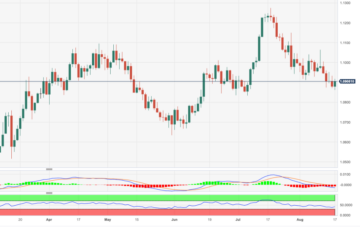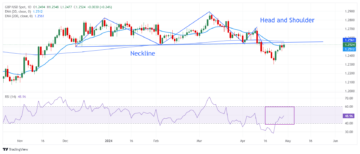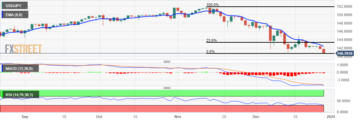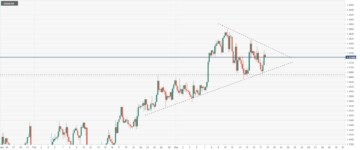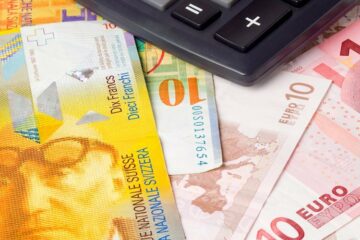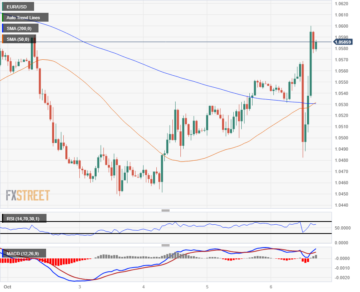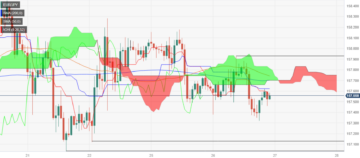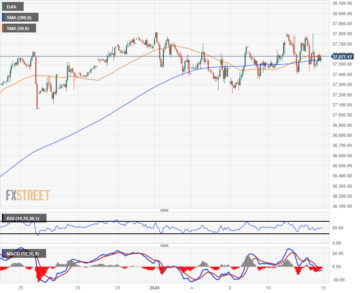- Australian Dollar gains ground on the weaker US Dollar on Monday.
- Australia’s ASX 200 index rises on higher mining stocks.
- US Dollar loses ground after dovish comments from the Former Fed official James Bullard.
- Upbeat US PPI data increased the market bias of no rate cut by the Fed in March.
The Australian Dollar (AUD) starts the week by continuing its four-day winning streak on Monday. The US Dollar (USD) gained support from Friday’s release of better-than-anticipated Producer Price Index (PPI) data from the United States. However, gains were tempered by dovish remarks from former St. Louis Federal Reserve (Fed) president, James Bullard, thereby boosting the AUD/USD pair.
Australian Dollar also gains upward support as the S&P/ASX 200 index reaches an all-time high, driven by increased mining stocks amid stronger metals prices. Furthermore, market sentiment strengthens with the belief that the Reserve Bank of Australia (RBA) will maintain its current monetary policy stance throughout 2024, fueled by Westpac’s expectation of a resilient Australian economy supported by low unemployment and healthy corporate sector balance sheets. Westpac anticipates the RBA to adopt a less restrictive approach in 2025.
The US Dollar Index (DXY) extended its decline as US Treasury yields pared back their daily advances on Friday. With United States banks closed for the President’s Day bank holiday, markets anticipate limited movement in the US Dollar.
Daily Digest Market Movers: Australian Dollar appreciates on weaker US Dollar
- Reserve Bank of Australia Governor Michele Bullock addressed the Australian parliament’s Senate Economics Legislation Committee, noting that the global economy has fared better than initially anticipated. She expressed previous concerns about potential hard landings and recessions but indicated that the economy is currently in a favorable position to bring inflation down within a reasonable timeframe.
- Premier of the People’s Republic of China (PBoC), Li Qiang, emphasized the importance of maintaining consistent and stable policies. The PBoC opted to keep its Medium-term Lending Facility (MLF) rate unchanged at 2.5%.
- At the National Association for Business Economics (NABE) conference, Ex-fed James Bullard suggested that the Federal Reserve should consider lowering interest rates at its March meeting to avoid dampening economic activity due to higher rates.
- The preliminary Michigan Consumer Sentiment Index improved to 79.6 from 79.0 prior, lower than the expected reading of 80.0.
- The US Core Producer Price Index (YoY) improved by 2% in January, surpassing the expected 1.6% and 1.7% prior. While the MoM data showed a rise of 0.5%, against the expected 0.1% improvement from the previous decline of 0.1%.
- US Producer Price Index came in at 0.9% year-over-year compared to the anticipated 0.6% and previous growth of 1.0%. Meanwhile, monthly improvement was 0.3% against the previous decline of 0.1%.
- US Building Permits (MoM) contracted to 1.470 million in January, against the expected rise to 1.509 million from the previous 1.493 million.
Technical Analysis: Australian Dollar maintains its position above the support level of 0.6550
The Australian Dollar trades near 0.6560 on Monday, positioned above the immediate support at the major level of 0.6550. A break below this level could push the AUD/USD pair to navigate the key barrier around the nine-day Exponential Moving Average (EMA) at 0.6523 followed by the psychological support level of 0.6500. On the upside, the AUD/USD pair could find the key resistance region around the psychological level of 0.6600 before the 38.2 Fibonacci retracement level of 0.6606.
AUD/USD: Daily Chart
Australian Dollar price today
The table below shows the percentage change of Australian Dollar (AUD) against listed major currencies today. Australian Dollar was the strongest against the Euro.
| USD | EUR | GBP | CAD | AUD | JPY | NZD | CHF | |
| USD | 0.06% | -0.02% | 0.00% | -0.03% | -0.08% | 0.02% | -0.01% | |
| EUR | -0.06% | -0.08% | -0.05% | -0.08% | -0.13% | -0.04% | -0.06% | |
| GBP | 0.02% | 0.08% | 0.02% | -0.03% | -0.05% | 0.02% | 0.02% | |
| CAD | 0.00% | 0.06% | -0.02% | -0.03% | -0.08% | -0.01% | -0.01% | |
| AUD | 0.05% | 0.10% | 0.03% | 0.05% | -0.03% | 0.05% | 0.04% | |
| JPY | 0.09% | 0.13% | 0.08% | 0.07% | 0.05% | 0.08% | 0.07% | |
| NZD | 0.00% | 0.04% | -0.03% | 0.01% | -0.02% | -0.08% | -0.02% | |
| CHF | 0.01% | 0.06% | -0.02% | 0.01% | -0.02% | -0.07% | 0.02% |
The heat map shows percentage changes of major currencies against each other. The base currency is picked from the left column, while the quote currency is picked from the top row. For example, if you pick the Euro from the left column and move along the horizontal line to the Japanese Yen, the percentage change displayed in the box will represent EUR (base)/JPY (quote).
Australian Dollar FAQs
One of the most significant factors for the Australian Dollar (AUD) is the level of interest rates set by the Reserve Bank of Australia (RBA). Because Australia is a resource-rich country another key driver is the price of its biggest export, Iron Ore. The health of the Chinese economy, its largest trading partner, is a factor, as well as inflation in Australia, its growth rate and Trade Balance. Market sentiment – whether investors are taking on more risky assets (risk-on) or seeking safe-havens (risk-off) – is also a factor, with risk-on positive for AUD.
The Reserve Bank of Australia (RBA) influences the Australian Dollar (AUD) by setting the level of interest rates that Australian banks can lend to each other. This influences the level of interest rates in the economy as a whole. The main goal of the RBA is to maintain a stable inflation rate of 2-3% by adjusting interest rates up or down. Relatively high interest rates compared to other major central banks support the AUD, and the opposite for relatively low. The RBA can also use quantitative easing and tightening to influence credit conditions, with the former AUD-negative and the latter AUD-positive.
China is Australia’s largest trading partner so the health of the Chinese economy is a major influence on the value of the Australian Dollar (AUD). When the Chinese economy is doing well it purchases more raw materials, goods and services from Australia, lifting demand for the AUD, and pushing up its value. The opposite is the case when the Chinese economy is not growing as fast as expected. Positive or negative surprises in Chinese growth data, therefore, often have a direct impact on the Australian Dollar and its pairs.
Iron Ore is Australia’s largest export, accounting for $118 billion a year according to data from 2021, with China as its primary destination. The price of Iron Ore, therefore, can be a driver of the Australian Dollar. Generally, if the price of Iron Ore rises, AUD also goes up, as aggregate demand for the currency increases. The opposite is the case if the price of Iron Ore falls. Higher Iron Ore prices also tend to result in a greater likelihood of a positive Trade Balance for Australia, which is also positive of the AUD.
The Trade Balance, which is the difference between what a country earns from its exports versus what it pays for its imports, is another factor that can influence the value of the Australian Dollar. If Australia produces highly sought after exports, then its currency will gain in value purely from the surplus demand created from foreign buyers seeking to purchase its exports versus what it spends to purchase imports. Therefore, a positive net Trade Balance strengthens the AUD, with the opposite effect if the Trade Balance is negative.
- SEO Powered Content & PR Distribution. Get Amplified Today.
- PlatoData.Network Vertical Generative Ai. Empower Yourself. Access Here.
- PlatoAiStream. Web3 Intelligence. Knowledge Amplified. Access Here.
- PlatoESG. Carbon, CleanTech, Energy, Environment, Solar, Waste Management. Access Here.
- PlatoHealth. Biotech and Clinical Trials Intelligence. Access Here.
- Source: https://www.fxstreet.com/news/australian-dollar-extends-winning-streak-on-higher-asx-200-index-amid-subdued-us-dollar-202402190141
- :has
- :is
- :not
- $UP
- 1
- 2%
- 200
- 2021
- 2024
- 2025
- 32
- 35%
- 36
- 41
- 5
- 50
- 6
- 80
- a
- About
- above
- According
- Accounting
- activity
- addressed
- adjusting
- adopt
- advances
- After
- against
- aggregate
- along
- also
- Amid
- an
- analysis
- and
- Animate
- Another
- anticipate
- Anticipated
- anticipates
- approach
- ARE
- around
- AS
- Assets
- Association
- ASX
- ASX 200
- At
- AUD
- AUD/USD
- Australia
- Australian
- Australian dollar
- average
- avoid
- back
- Balance
- balance sheets
- Bank
- Banks
- barrier
- base
- BE
- because
- before
- belief
- below
- Better
- better-than-anticipated
- between
- bias
- Biggest
- Billion
- boosting
- Box
- Break
- bring
- Building
- business
- but
- buyers
- by
- came
- CAN
- case
- central
- Central Banks
- change
- Changes
- China
- chinese
- closed
- Column
- comments
- committee
- compared
- Concerns
- conditions
- Conference
- Consider
- consistent
- consumer
- consumer sentiment
- content
- continuing
- Core
- Corporate
- could
- country
- created
- credit
- currencies
- Currency
- Current
- Currently
- Cut
- daily
- data
- day
- Decline
- Demand
- destination
- difference
- Digest
- direct
- displayed
- doing
- Dollar
- dollar index
- Dovish
- down
- driven
- driver
- due
- Dxy
- each
- easing
- Economic
- Economics
- economy
- effect
- EMA
- emphasized
- ends
- EUR
- Euro
- example
- expanded
- expectation
- expected
- exponential
- exponential moving average
- export
- exports
- expressed
- extended
- extends
- Facility
- factor
- factors
- Falls
- FAQ
- FAST
- favorable
- Fed
- Federal
- federal reserve
- Find
- followed
- For
- foreign
- Former
- Friday
- from
- from 2021
- fueled
- Furthermore
- Gain
- gained
- Gains
- generally
- Global
- Global economy
- goal
- Goes
- goods
- Governor
- greater
- Ground
- Growing
- Growth
- Hard
- Have
- Health
- healthy
- High
- higher
- highly
- Holiday
- Horizontal
- However
- HTTPS
- if
- immediate
- Impact
- importance
- imports
- improved
- improvement
- in
- increased
- Increases
- index
- indicated
- inflation
- inflation rate
- influence
- initially
- interest
- Interest Rates
- Investors
- IT
- ITS
- james
- January
- Japanese
- Japanese Yen
- Keep
- Key
- key resistance
- landings
- largest
- left
- Legislation
- LEND
- lending
- less
- Level
- li
- lifting
- likelihood
- Limited
- Line
- Listed
- Loses
- Louis
- Low
- lower
- lowering
- Main
- maintain
- maintaining
- maintains
- major
- map
- March
- Market
- market sentiment
- Markets
- materials
- Meanwhile
- meeting
- Metals
- Michigan
- million
- Mining
- MLF
- module
- mom
- Monday
- Monetary
- Monetary Policy
- monthly
- more
- most
- move
- movement
- Movers
- moving
- moving average
- National
- Navigate
- Near
- negative
- net
- no
- noting
- of
- official
- often
- on
- opposite
- or
- Other
- pair
- pairs
- parliament
- partner
- pays
- PBOC
- People
- percentage
- permits
- pick
- picked
- plato
- Plato Data Intelligence
- PlatoData
- policies
- policy
- position
- positioned
- positive
- potential
- ppi
- preliminary
- president
- previous
- price
- Prices
- primary
- Prior
- producer
- produces
- psychological
- purchase
- purchases
- purely
- Push
- Pushing
- quantitative
- Quantitative Easing
- quote
- Rate
- Rates
- Raw
- RBA
- Reaches
- Reading
- reasonable
- region
- relatively
- release
- represent
- Republic
- Reserve
- reserve bank
- reserve bank of australia
- Reserve Bank of Australia (RBA)
- resilient
- Resistance
- Restrictive
- result
- retracement
- Rise
- Rises
- Risky
- ROW
- s
- sector
- seeking
- Senate
- sentiment
- Services
- set
- setting
- she
- sheets
- should
- showed
- Shows
- significant
- So
- sought
- spends
- st
- stable
- stance
- starts
- States
- Stocks
- Strengthens
- stronger
- strongest
- support
- support level
- Supported
- surpassing
- surplus
- surprises
- table
- taking
- tend
- than
- that
- The
- the Fed
- their
- then
- thereby
- therefore
- this
- throughout
- tightening
- timeframe
- to
- today
- top
- trade
- trades
- Trading
- treasury
- Treasury yields
- unemployment
- United
- United States
- Upside
- upward
- us
- US Dollar
- US Dollar Index
- US PPI
- US Treasury
- US treasury yields
- USD
- use
- value
- Versus
- was
- weaker
- week
- WELL
- were
- Westpac
- What
- when
- whether
- which
- while
- whole
- will
- winning
- with
- within
- year
- Yen
- yields
- you
- zephyrnet


